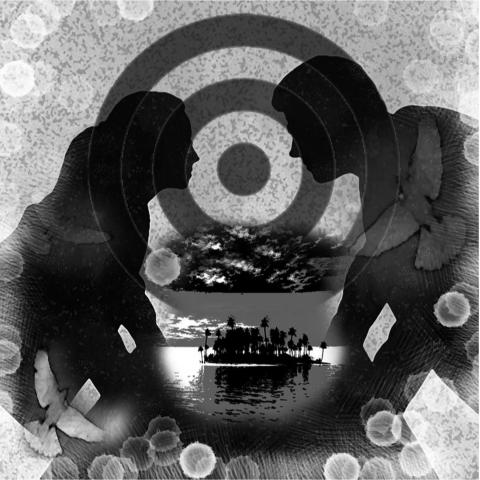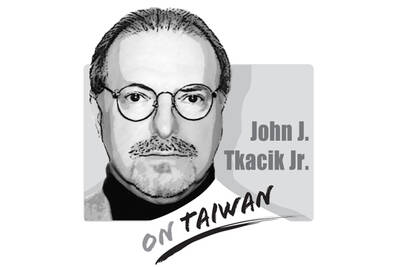China’s newest city is a remote island in the South China Sea barely large enough to host a single airstrip. It has a post office, bank, supermarket and a hospital, but little else. Fresh water comes by freighter on a 13-hour journey from China’s southernmost province.
Welcome to Sansha (三沙), China’s expanding toehold in the world’s most disputed waters, portions of which are claimed by Taiwan, Vietnam, Brunei, Malaysia and the Philippines. On Tuesday, as blustery island winds buffeted palm trees, a new mayor declared Sansha to be China’s newest municipality.
Beijing has created the city administration to oversee not only the rugged outpost with a population of just 1,000, but also hundreds of thousands of square kilometers of water where it wants to strengthen its control over disputed — and potentially oil-rich — islands.

The Philippines said it does not recognize the city or its jurisdiction, and Vietnam said China’s actions violated international law. The US also voiced its concern over “unilateral moves” in the South China Sea where it says collective diplomacy is needed to resolve competing claims.
The city administration is on tiny Woody Island (Yongxing Island, 永興島), 350km southeast from China’s tropical Hainan Island. The Cabinet approved Sansha last month to “consolidate administration” over the Paracel (Xisha Islands, 西沙群島) and Spratly (Nansha Islands, 南沙群島) archipelagos and the Macclesfield Bank (Zhongsha Islands, 中沙群島), a large, completely submerged atoll that boasts rich fishing grounds that is claimed by Taiwan and the Philippines.
Taiwan, Vietnam and China claim the Paracels, of which Woody Island, little more than half the size of Manhattan’s Central Park, is part. The three countries along with the Philippines, Malaysia and Brunei also claim all or parts of the Spratlys.
China claims virtually the entire South China Sea and its island groups, and its disputes occasionally erupt into open confrontation. The islands, many of them occupied by garrisons from the various claimants, sit amid some of the world’s busiest commercial sea lanes, along with rich fishing grounds and potential oil and gas deposits. China has approved the formal establishment of a military garrison for Sansha, though specific details have yet to be released.
Official broadcaster China Central Television aired Tuesday morning’s formal establishment ceremony live from Sansha, with speeches from the new mayor and other officials.
The Chinese flag was raised and national anthem played before plaques for the Sansha Municipal Government and the Sansha Municipal Committee of the Communist Party of China were unveiled on a white-columned government building.
Mayor Xiao Jie (肖杰) trumpeted Sansha’s important role in protecting China’s sovereignty. He said the designation of Sansha as a new city was “a wise decision made by the party and the government of China to protect the sovereign rights of China, and to strengthen the protection and the development of natural resources.”
The official Xinhua news agency reported earlier that Sansha’s jurisdiction covers just 13km2 of land, including other islands and atolls in the South China Sea around Woody Island, but 2 million square kilometers of surrounding waters.
Sansha means “three sandbanks” in Mandarin and appears to refer to the Chinese names for the disputed island chains and atoll, known in Chinese as the West, South and Middle islands, or Xisha, Nansha and Zhongsha.
A description from a former People’s Liberation Army officer who was among the officials overseeing the island before Sansha was established paints a picture of a harsh and isolated post where officials rotate staffing for a month at a time. However, he said fishermen live there all year round.
“The living conditions are pretty simple,” said Tan Xiankun, director of the office in Hainan overseeing Xisha and other South China Sea territories, in 2010. “It’s very humid and hot, more than 30?C, and there’s salt everywhere. There’s no fresh water, except for what’s shipped in and what’s collected from rain water.”
Philippine Department of Foreign Affairs spokesman Raul Hernandez said Manila has expressed its concern and registered a strong protest with Beijing over the decision to set up a military garrison on Sansha.
“The Philippines does not recognize the Sansha city and the extent of its jurisdiction and considers recent measures taken by China as unacceptable,” Hernandez told a news conference.
Vietnam’s Foreign Ministry spokesman Luong Thanh Nghi said that Vietnam had protested to the Chinese foreign ministry.
“China’s establishment of the so-called ‘Sansha City’ ... violated international law, seriously violating Vietnam sovereignty over the Paracel and Spratly archipelagos,” the statement said.
Asked about the establishment of the city, US Department of State spokeswoman Victoria Nuland told a news briefing on Tuesday: “We remain concerned should there be any unilateral moves of this kind that would seem to prejudge an issue that we have said repeatedly can only be solved by negotiations, by dialogue and by a collaborative diplomatic process among all the claimants.”
The US says it does not take a position on the competing sovereignty claims over land features in the South China Sea, but has a national interest in freedom of navigation in its busy sea lanes and in maintenance of peace and stability.
A report released on Tuesday by the International Crisis Group think tank said that although China’s large claim to the South China Sea and its assertive approach has rattled other claimants, Beijing is “not stoking tensions on its own.”
“South East Asian claimants, with Vietnam and the Philippines in the forefront, are now more forcefully defending their claims — and enlisting outside allies — with considerable energy,” it said, a reference to Washington’s move to influence the Asian balance of power by supporting China’s neighbors.
The report also warned that the risk of escalation was high and urged claimants to find ways to jointly manage energy resources and fishing areas while also agreeing on a mechanism for handling incidents.
“In the absence of such a mechanism, tensions in the South China Sea could all too easily be driven to irreversible levels,” it said.
A 50-year-old on Wednesday last week died while under anesthesia at a Taipei cosmetic clinic shortly after undergoing a penis enlargement procedure. The surgeon was arrested for suspected medical malpractice, again bringing to the surface shortcomings in the regulation of cosmetic medicine. Media reports said the clinic owner and surgeon, surnamed Ting (丁), was previously convicted of negligent homicide for a postsurgical death and had been charged with coercion and aggravated assault after allegedly stopping a patient from calling for an ambulance. He had also been fined for failing inspections and had allegedly permitted people without medical licenses to assist

It was most annoying last week to read Chairman Xi Jinping’s (習近平) fulsome encomium to the People’s Liberation Army during the Eightieth Anniversary celebrations of victory over Japan in World War II. Comrade Xi’s soaring rhetoric was stuffed with “martyrs, sacrifice, solemnity and unwavering resolve” in praise of the “Chinese People’s War of Resistance Against Japanese Aggression and the World Anti-Fascist War.” His aspirations overflowed with “world peace” and love of the United Nations, of which China is a founding member. The Liberation Army Daily said that every word from General Secretary Xi Jinping “resounded in his powerful voice, illuminating the
OpenAI CEO Sam Altman recently sat down for an interview with former Fox News host Tucker Carlson in which he openly acknowledged that ChatGPT’s model behavior is indeed influencing the entire world, and that he himself is responsible for the decisions related to the bot’s moral framework. He said that he has not had a good night of sleep since its launch, as the technology could bring about unpredictable consequences. Although the discussion took place in the US, it is closely related to Taiwan. While Altman worries about the concentration of power, the Chinese Communist Party (CCP) has already weaponized artificial
When a Reuters reporter asked Chinese Ministry of Foreign Affairs spokesman Lin Jian (林劍) about Minister of Foreign Affairs Lin Chia-lung’s (林佳龍) European tour, Lin Jian expressed displeasure, referring to Lin Chia-lung as “merely a local foreign affairs official in China,” and reiterating the Chinese Communist Party’s (CCP) oft-used claim that Taiwan is a Chinese “province.” This response is a political falsehood. Although such statements have become standard fare in the CCP’s external messaging, they expose its deepest anxieties. The CCP fears confronting international reality and is even unnerved by the prospect of Taiwan’s subjectivity on the world stage. The CCP